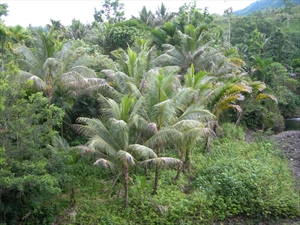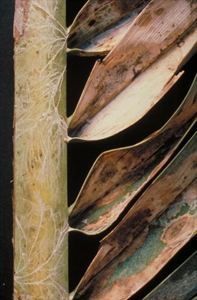Coconut thread blight
Pacific Pests, Pathogens, Weeds & Pesticides - Online edition
Pacific Pests, Pathogens, Weeds & Pesticides
Coconut thread blight (167)
Corticium penicillatum
Southeast Asia, Oceania. It is reported from Fiji, Papua New Guinea, Samoa, Solomon Islands, and Vanuatu.
Coconut
The fungus that causes thread blight was first described in the 1920s from Papua New Guinea and Vanuatu, and both its taxonomy and biology need to be re-examined.
Infection occurs on the underside of a leaflet, in the middle, and then the threads of the fungus travel to the leaf midrib (called the 'rachis'). The threads travel up and down the midrib (Photo 3), confined to the underside, colonising the leaflets one after the other. Rots develop beginning near the midrib and these destroy the leaflets (Photo 4), although the tips remain green for a while (Photo 5). The midrib of the frond does not appear to be injured by the fungus.
No spore-producing fungus has been described for this disease, although it is presumed that initial infection of the leaflets are caused by airborne spores. Infection also occurs by leaf-to-leaf contact. It is said that in Papua New Guinea, thread blight can withstand desiccation from sun and drying winds.
The affected parts of the leaves become necrotic and dry. Occasionally, entire fronds are attacked, and these die, and fall prematurely. But mostly the disease occurs in patches on the older fronds, often at the ends.
Usually, thread blight is a minor disease, unless the palms are shaded. However, in the wet areas in the interior of some Pacific islands it is severe, and possibly reducing yield.
Look for patches of dead leaflets on the older fronds with white threads over them and along the midribs. From a distance, and especially in the evening, these white patches are very noticeable.
CULTURAL CONTROL
Before planting:
If planting in high rainfall areas, look to see if thread blight occurs there. If it does, or it is likely to occur, do the following:
- Do not plant coconuts beneath shade. High humidity will increase the chances of thread blight infection.
- Do not plant blocks of coconuts at close spacing; allow more than the normal spacing (7-5 x 7.5 m), or consider planting intercrops between rows of coconuts to reduce the density of palms per ha.
- Do not plant coconuts in the middle of forests which stop the free flow of wind through the blocks. Wind is needed to help dry the surface of leaflets to reduce the chance of thread blight infection.
- Plant coconuts on hill slopes that face the morning sun so that leaflets dry out as soon as possible. Avoid long periods of leaf wetness, as this will increase the chances of thread blight infection.
- When first seen, cut out and burn infected leaves.
RESISTANT VARIETIES
There is nothing known about the differences between varieties to this disease.
CHEMICAL CONTROL
This is not an appropriate method of control for this disease. Chemical control is uneconomic because of the low value of coconuts per unit area; additionally, it is impractical to apply fungicides except to young palms.
AUTHOR Grahame Jackson
Information from Corticium penicillatum. Wikipedia. (https://en.wikipedia.org/wiki/Corticium_penicillatum). Photos 3&4 Kohler F, et al. (1997) Diseases of cultivated crops in Pacific Island countries. South Pacific Commission. Pirie Printers Pty Limited, Canberra, Australia.
Produced with support from the Australian Centre for International Agricultural Research under project PC/2010/090: Strengthening integrated crop management research in the Pacific Islands in support of sustainable intensification of high-value crop production, implemented by the University of Queensland and the Secretariat of the Pacific Community.








